Daredevil #1 (Marvel Comics, $3.99)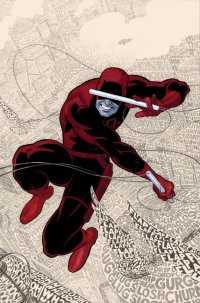
By Devon Sanders
Daredevil, over the past eight years has had his secret identity exposed, helped drive his ex-wife insane, been sent to prison, entered into an alliance with his worst enemy, The Kingpin, took over an evil ninja clan, started a war and died.
Having said all of this, Marvel did what any sensible steward would and said, “Geez, this guy needs to lighten up,” and did something about it. Thus, the need for Daredevil #1, a true sea change for the so-called, “Man Without Fear.”
Having survived whatever a few of Marvel’s best writers have thrown at him, Daredevil and more importantly, his alter ego of Matt Murdock, following an awesome fight with dimension-hopping assassin, The Spot, find themselves in brand rebuilding and self-discovery modes, respectively with both being wonderfully executed in two tales by series writer Mark Waid. Both find Daredevil, in a journey of reclamation, redefining himself in a world that’s already made up its mind about who he is and who he will be. No mean feat and what Waid does here is deliberately hash out DD’s past while cleverly laying out a potentially exciting future course. It’s all done cleverly and promises to engross Daredevil readers, new and old.
Art chores on Daredevil #1 are handled two of comics’ most exciting talents, Paolo Rivera and Marcos Martin, both of Amazing Spider-Man fame. Rivera’s art in the first story, “Man W/O Fear” is fluid and truly inspired. His figure work and choice of panel layout is uncluttered and shows a true understanding of exactly what a story needs. Martin, artist on the second story, just may have done the impossible and one-upped Rivera, utilizing imaginative, flowing panel layouts and inspired “camera angles” tailor-made for Daredevil and New York.
Daredevil #1, with an ending you’ll want to follow-up on and its understanding of who this character is, was and who he could be is exactly the Daredevil comic I’ve been looking for over the past eight years.
Rating: 




Out of a Possible 5 Stars
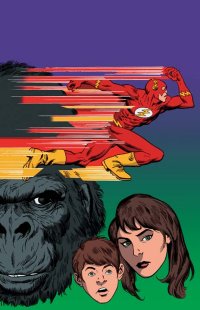 DC Retroactive 1970’s: The Flash one-shot
DC Retroactive 1970’s: The Flash one-shotDC Retroactive 1970’s: Batman one-shot
(DC Comics, $4.99 each)
by Graig Kent
With all the hoopla surrounding “the New 52”, DC Comics’ risky relaunch of its superhero line in September, their DC Retroactive series of one-shots running over the next six weeks leading into the reboot is well-timed. The relaunch has been greeted with heavy trepidation by a great many long-time readers, with more than a few old guard stating they’re not going to be sticking around to see it all change. In this regard, DC Retroactive serves a dual purpose: the first, to feed those old guard some new stories in familiar settings, maybe triggering fond memories in reflecting both artistic and storytelling styles, some which long since passed. Perhaps this endeavor is DC’s last hope at sucking a few bucks out of the departing naysayers, but perhaps, more shrewdly, the hope is instead for the second purpose of showing the 20-plus-years-loyal DC readers just how much the books have already changed from the 1970’s to the ’80’s to the ’90’s to today.
Each Retroactive book features an original story by a classic creator tied to the character from the era, in the case of the DC Retroactive 1970’s: The Flash one-shot, it’s got to be Cary Bates, who saw Barry Allen through the majority of his adventures in an utterly impressive run (no pun intended) from 1971 through to the end of the series in 1985. Throughout most of ’70’s Bates was accompanied by artist Irv Novick and later in the ’80’s primarily – and most notably – by Carmine Infantino. (One can only wonder how Bates felt after 14 years working on and building Barry Allen, only to have him taken away and killed off in the Crisis.) I have to admit my investment in pre-Crisis Flash is limited to a handful of the Infantino years on the title, so while Bates’ Flash isn’t necessarily unfamiliar, he’s also not intimately familiar. Yet, in this issue, I do recognize Barry Allen as I remember him, and his supporting cast members like Iris Allen and Solovar are there too. In the set-up the Flash is in Gorilla City getting the results of a virility test, Solovar giving him the bad news that his superpowers have rendered his little soldiers inert. The Flash’s nemesis Gorilla Grodd, meanwhile, is back in Central City, enacting a ludicrously elaborate scheme to discredit and emotionally destroy the Flash, involving the blending of Barry, Iris and Grodd’s DNA into a hyper-accelerated-aging, human-looking boy named Darok who has his father’s telepathic prowess and controls a seriously powerful suit of gorilla armor. Bates’ script is so riddled with ridiculously out-there ideas, and the story is told with such an excitable narration that one couldn’t be blamed for actually mistaking this as an actual bona-fide ’70’s issue of the Flash.
Of course, it’s not an authentic ’70’s issue of the Flash because Irv Novick has passed. I can’t proclaim to be familiar enough with Novick’s work to know whether Spanish artist Benito Gallego (with legendary artist Sal Buscema on inks) faithfully recreates his style, but Gallego certainly has a feel for that era of illustrating, with plenty of stiff posturing and a goofy unnaturalness that accentuate the charmingly silly script. The most unfortunate aspect of the book is the reprint of DC Comics Presents #2, and I say “unfortunate” rather lightly because it’s a gorgeously illustrated Superman/Flash team-up by Jose Luis Garcia Lopez from a ripping Martin Pasko script. No, it’s unfortunate because it would have been great to see a classic Bates/Novick reprint of the actual “The Flash: The Fastest Man Alive” comic, perhaps even one that had a back-up feature as the ’70’s book so often did.
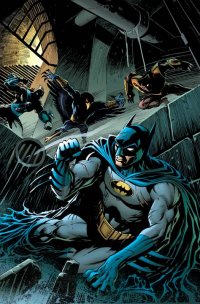 Over to DC Retroactive 1970’s: Batman, which is written by Len Wein. Wein is certainly one of the most omnipresent writers in comics over the past four decades, but his association with Batman in the era was actually a rather brief. Paired with artist Marshall Rogers, Wein had the somewhat unfortunate task of following the infamous Steve Englehart/Rogers storyline featuring Hugo Strange and Silver St. Cloud that ran through Detective Comics in 1977 (collected more recently in the “Strange Apparitions” trade paperback) that was like the “Batman: Hush” of its day. Wein followed up his ‘Tec run with a stint on Batman in 1979, of which a reprint of his issue #307 is the back-up feature here.
Over to DC Retroactive 1970’s: Batman, which is written by Len Wein. Wein is certainly one of the most omnipresent writers in comics over the past four decades, but his association with Batman in the era was actually a rather brief. Paired with artist Marshall Rogers, Wein had the somewhat unfortunate task of following the infamous Steve Englehart/Rogers storyline featuring Hugo Strange and Silver St. Cloud that ran through Detective Comics in 1977 (collected more recently in the “Strange Apparitions” trade paperback) that was like the “Batman: Hush” of its day. Wein followed up his ‘Tec run with a stint on Batman in 1979, of which a reprint of his issue #307 is the back-up feature here.
Wein’s run on Batman presented relatively traditional comic book stories of the good guy versus the bad guys, but told them with a more ominous tone. Batman, still wearing blue and grey, wasn’t nearly as dark as he is now and Wein presented him as often as a man of action and gadgets as he did a detective. In the story here, Batman faces off against the new Terrible Trio, equipped with high-tech vehicles and professional-grade costumes. Though never able to defeat him, they do give him a challenge, and we all know Batman is up for a challenge. Meanwhile, Lucious Fox is having trouble with his son. Are the two connected? Of course they are.
Wein’s script gets a little ham-fisted, especially surrounding the Lucious Fox and Son storyline, which seems like a left-field curveball sequence of events shoehorned in to give it some added melodrama. Tom Mandrake is better known for his runs with John Ostrander on the Spectre and Martian Manhunter in the 1990’s but had a year long run with the character in the mid-’80’s, and the occasional return to the character since. Though he does have a Kubert School style, it’s darker and heavier than what you’d tend to find in the ’70’s but his experience with Batman makes him a pretty good fit for Wein’s script.
Neither of these books is particularly necessary, but treated as a treat for those of us who were there, or curiosities for who weren’t, they do offer both a sense of fun and perspective on where we were, and where we’re going to.
Both – Rating: 




Out of a Possible 5 Stars
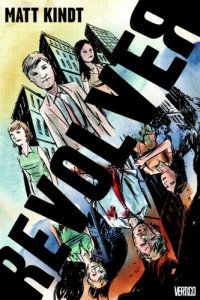 Revolver TPB (Vertigo, $19.99)
Revolver TPB (Vertigo, $19.99)by Graig Kent
Imagine waking up to a world changing right before your eyes, chaos raining down around you, and within those 24 hours everything you know about the world and ourself is wrong. You don’t have to imagine too hard, just think back to what it was like waking up on September 11 ten years ago and those memories will start flooding back. Sure, most people’s lives, and civilization in general didn’t change as dramatically as it does at the beginning of Matt Kindt’s original graphic novel Revolver, but in reading the opening pages one can easily relate to the reality Kindt’s lead Sam finds himself in. Going from the everyday trudge of doing a job you resent into a world of chaos and disorder is equal parts fantasy and nightmare for those of us stuck in an (at best) 9 to 5 world. Revolver’s opening scenes effectively explore what it’s like to let free all the angst of feeling powerless and helpless in your life via violence, a catharsis that (no surprise) doesn’t actually make you feel better, more in charge, or liberated. The new world in Revolver is an exaggerated version of the post 9-11 events, except here, there were even more targets of attack across the US that succeeded, the manhunt was not for a rich, religiously fanatical terrorist leader in Afghanistan, but for an anarchist billionaire centered out of the United States. The military put the country on lockdown, access to most of the news sources are impossible, nobody knows what’s going on, who the enemy is, and whether the government is out to protect its people, control them, or kill them. Chaos reigns.
In other words, a true waking nightmare.
Now imagine you go back to sleep, and wake up again in your own bed, the world is once again as it was, the everyday trudge resuming as usual. You can still recall the nightmare, vividly, but things are pretty much the same again. But you’re not. Sam’s life had changed for a day, his world shattered around him. That job he hated was gone, and that boss he loathed, Jan, turned out to actually be a pretty awesome human being. Sam beat a guy to death with his bare hands. Though it felt like it happened, did it really? His girlfriend Maria doesn’t seem any different, still as fixated on things like flatware and clothing as ever, and more annoyed than concerned with Sam’s shift in demeanor. What’s going on. Sam goes back to sleep, and the world is chaos again. And each night it happens like that, flipping Sam back and forth between a liberating nightmare and life of confining comfort. In one world he begins to realize that he can affect change, in the other he’s still helpless, repressed. But he’s not, not anymore. Knowledge from the comfortable world can help him in the chaotic world, and he realizes the reverse can be true as well. But can he continue to live in both, does he want to? And if he had to choose, which would it be. It’s an existential crisis manifested real.
Matt Kindt has become a trusted name to me. Like Grant Morrison or Jonathan Hickman, Kindt has ideas and he backs them up with his execution, thinking things through in a way that is both exciting and fresh, but at the same time natural. Kindt’s forays into the fantastic come from a grounded focal point, using one or multiple characters to show the human side to bigger-than-life scenarios. Working outside of cliches, he approaches situations from not a story perspective but a character perspective so the choices may be surprising but are always befitting the character. His art style is uniquely his own, not pretty but exceptionally effective. His loose lines are given weight with shifting 2-tone ink washes, shifting between sepia tone and blue. Though it may not be the most attractive, Kindt’s visual storytelling is powerful, those opening moment of destruction occurring around Sam, for instance, are terrifying. The conceit of the book is used perfectly, both as entertaining and to hit hard the allegory the story casts, while Kindt’s masterstroke was to incorporate the page numbering within a “news ticker” across the bottom of the page, one that shifts dramatically in tone depending on which world Sam is in.
Revolver is impressive, smart, engrossing, though provoking and enjoyable. It’s about as good as the medium gets.
Rating: 




Out of a Possible 5 Stars
Sergio Aragonés Funnies #1 (Bongo Comics, $3.50)
by Graig Kent
Sergio Aragonés is a fixture of the comics landscape. It seems like he’s always been there, and it seems like he will continue to be around forever. Thanks to his nearly 50 years of service over at Mad Magazine (as well as more recent contributions to Simpsons comics), Aragonés is continually introduced to a new generation of readers, each as equally receptive to the illustrator’s rotund cartoon creations and his clever marginalia as the last, thanks in no small part to his frequent use of innocent innuendo in his comics. Perhaps his impact on the medium isn’t as great as Jack Kirby or Steve Ditko, but I’d wager his name is as well known, if not more so. Many people, like myself, probably stopped getting a regular dose of Aragonés in their early teens, having grown past the juvenile humor of Mad Magazine (ok, most boys never grow past that kind of humor, it’s just not all that cool or daring as a teen like it was when you were 12) but anyone still reading comics no doubt continues to cross paths with his work.
The debut issue of Sergio Aragonés Funnies is the first time I can recall seeing such a concentrated dose of the maestro`s work outside of Mad magazine collections, but this one, as Aragonés explains in the opening page, is a little more personal. In the middle of his usual milieu of black and white pantomime gags, full-color long-form comedy sketches, and a couple of activity pages (all-new, it should be noted) is a personal anecdote about the time he wrangled together a gaggle of his college classmates to fill out the background of a Daniel Boone film shoot. In all cases, Aragonés humor and charm emanate from the page. Even at 73, his illustrations, are as expressive and detail rich as they ever have been, and the man shows no signs of slowing down.
As with all titles in the Bongo Comics Group, Sergio Aragonés Funnies is an all-ages book. The activity pages may skew to a younger crowd, but I resist any reader to not participate in trying to find the two identical comic book covers in his hyper-detailed comic book store challenge page. Some of Aragonés references may be for an older generation (what kid under 20 is going to know who Daniel Boone is these days?) but they’re easy enough to get the gist of (and there’s no harm in reading the book with your kids to answer questions). For older readers, the book is like welcoming an old friend, while younger readers may find it to be like having a visit from an eccentric, excitable, jovial uncle. Either way it’s a good time.
Rating: 




Out of a Possible 5 Stars
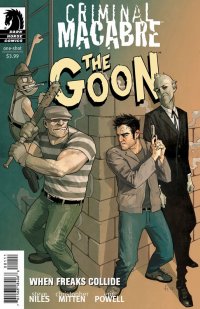 Criminal Macabre / The Goon: When Freaks Collide (Dark Horse, $3.99)
Criminal Macabre / The Goon: When Freaks Collide (Dark Horse, $3.99)
By Jeb D.
If there was ever any doubt that what raises The Goon from amusing trifle to the top level of today’s comics is not Eric Powell’s twisted sense of humor or EC-inspired story construction, but his artwork–a gorgeous mixture of pencil, water color, and whatever else he can lay his hands on, in a style that pays homage to 50’s sci-fi movie posters, early Mad magazine, pulp magazine covers, luchadora, Gene Colan, rockabilly, and similar touchstones of geek culture–well, it’s a comic like this one: Powell’s characters under someone else’s pen (well, word processor) and pencils.
Mind you, if anyone was going to be able to approximate the rough charm of The Goon, it was horror comic honcho Steve Niles (Powell is credited with “farts and negativity”). I’ve only read a bit of his Criminal Macabre series, featuring hard-boiled paranormal punisher Cal McDonald, but his work in general shows that he shares Powell’s understanding of the gross-out aesthetic. And if you were going to hook up McDonald and the ghoulish Mo’Lock, and The Goon and his endearlingly appalling sidekick Frankie, with any other writer working today, Niles was the guy.
But that’s kind of a big “if.” Honestly, is there anything more pointless in comics than the story where a pair of heroes meet up, have a misunderstanding, fight to a standoff, then unite against the real enemy? Particularly when it’s all crammed into a single issue? At least in a mini-series you could get the predictable stuff out of the way and move on to telling a story, but in 22 pages, there’s barely time for more than the meet-cute. And the storyline here really is just that predictable. The script is serviceable–the bantering between Mo’Lock and Frankie is well-characterized, and the real highlight of the book–but it’s so by-the-numbers that it would take artwork from someone as gifted as Powell to make it a recommendation, and Christopher Mitten’s blocky Mignola-like style tells the story well enough (he’s drawn Criminal Macabre in the past), but doesn’t add the extra element that would tip it into the memorable category. It’s particularly noticeable when you compare it with Powell’s alternate wraparound cover, a gorgeous tip of the hat to Jack Davis and Frank Frazetta.
The book ends on a punchline that I won’t spoil, but beyond that, this really is only of interest to committed fans of Niles or fanatic collectors of The Goon; for anyone else, Niles and Powell have more interesting offerings out there for you.
Rating: 




Out of a Possible 5 Stars
The Mis-Adventures of Adam West (Blue Water, $3.99)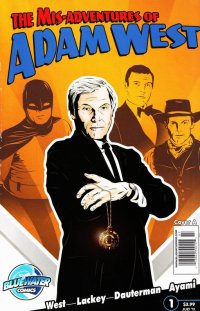
By Jeb D.
David Hasselhoff is a popsicle. The 80’s man-of-all-media is capitalizing on the ironic nature of his fame by endorsing a frozen confection in the shape of his sculpted torso. I have to say that it’s nice to see that his role model–Adam West, the man who practically created the “so-corny-it’s-cool” school of celebrity–is confining himself to starring in mediocre comic books. I suppose that’s a little dismissive–by the standards of Blue Water, this comic is probably in the upper twentieth or thirtieth percentile*–but beyond the warm smile that association with West’s over-the-top sincerity can still bring , there’s not much going on here.
The story opens with West having trouble finding work in today’s film business because he is rejecting the violent movie roles he is offered; he insists on playing characters who hold to the high standards of an earlier day (say, the era of the Batman TY show). As anyone knows who’s seen or read the interviews that West gives every time there’s a new Batman film or TV project, this is pretty much where the man stands in real life (whether that’s really what limits his film opportunities I will leave for others to debate). Dejected, our hero gets into his car, picks up a mysterious amulet that has been left there, and suddenly finds that he has transformed into a younger version of himself, and following a car crash and encounter with a femme fatale, we get the obligatory “where am I?” scene as the suddenly rejuvenated actor finds that he is “living” the part of the hero in one of the violent films he’d recently turned down. And at issue’s end, West’s character falls into the clutches of a suitably mysterious, powerful figure who has answers about the amulet, and the mystery he has plunged West into.
Given the star’s role in the project, writer Reed Lackey can be forgiven for delivering a fairly by-the-numbers script; since the story’s action shifts into the cliché-ridden world of the action film West turned down, having the dialog read like sound bites from a movie you’ve seen dozens of times is fairly a propos. And while there’s nothing new about this sort of magical-identity-transformation story, the better ones will use the phenomenon to give the protagonist some sort of perspective on the choices he’s made that brought him into the situation; it would seem unlikely, though, that this comic is going to wind up with much in the way of reflection the part of its star, since his character’s already committed to West’s real-life views.
Russell Dauterman’s art (with colors by Kamui Ayami) is capable enough; stiff during the talking heads segments, but competently paced during the action.
I’d always prefer to give a recommendation to smaller-press books, and I’m willing to stretch a point when it feels as though they’re reaching for something different or distinctive. But sans the involvement of everyone’s favorite ex-Caped Crusader, there’s really nothing here to hold your attention for an entire miniseries.
Rating: 




Out of a Possible 5 Stars
*I should also mention that Blue Water seems to be spinning off a new horror line from their series of celebrity biographies; at least that’s the implication I get from the full-page ad for a comic featuring the zombie-like visage of Keith Richards.